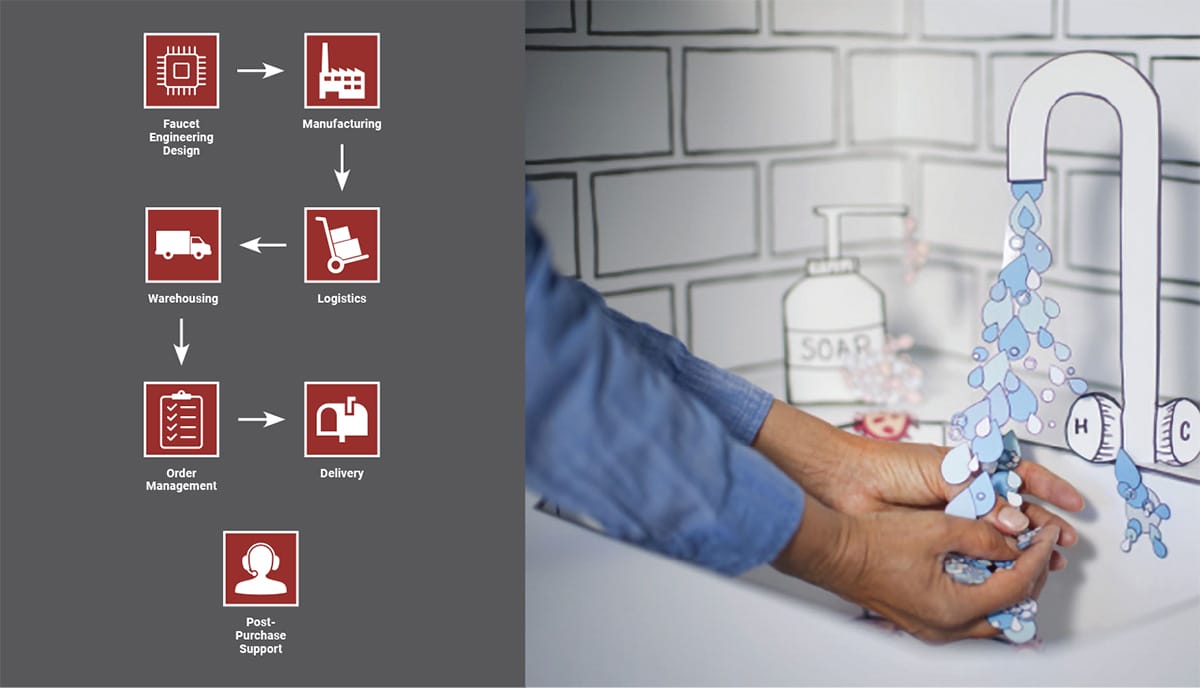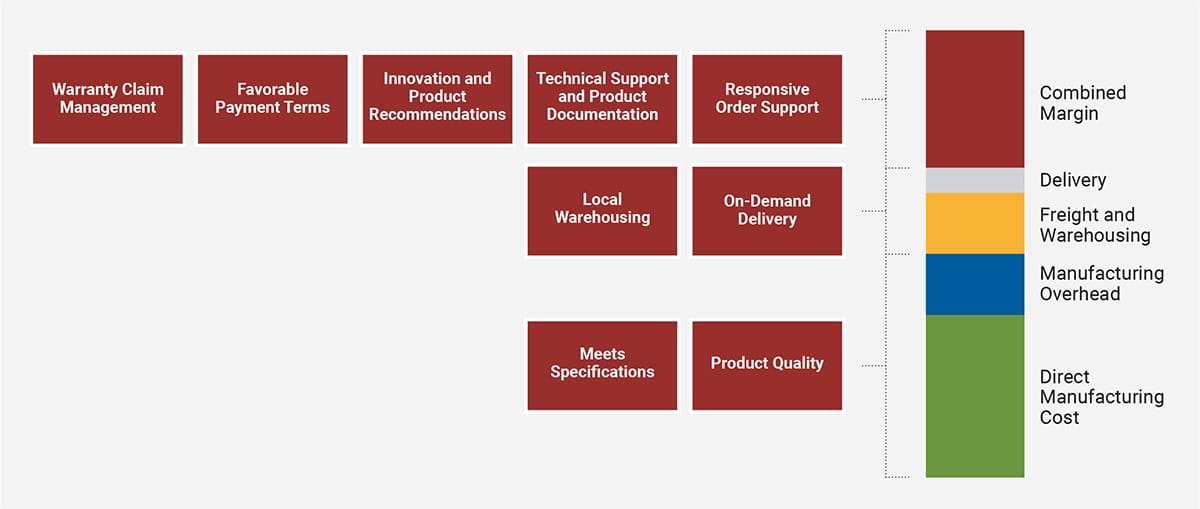Stop Accepting Non Value Added Building Materials in Modular Supply Chains

Jeremiah Osborn is the Supply Chain Director for Fading West
Building materials manufacturers and lumber mills have traditionally relied heavily on outside sales representatives and distributors to sell their products, and for many years this made sense. Having a few large customers with steady demand allowed them to focus on their key competency – manufacturing. Technology and logistics infrastructure did not support a large volume of smaller orders to thousands of customers.
This simply isn’t the case anymore.
Modern CRM and ERP systems make it easier for manufacturers to manage complex orders to multiple customers while still providing high levels of customer service and technical support. I will provide some specific examples of building materials manufacturers who I’m currently working with who have already begun to do this. As procurement professionals, we need to stop accepting high margins for non value added sales representatives and distributors by demanding more transparency and value.
Okay, but how do we actually do this?
This repeatable four step process will explain how to map out your supply chain value stream and provide some easy ways to remove waste. For this example I am going to use a national brand kitchen faucet purchased through a local plumbing distributor.

Step 1 – Break Down Your Cost Structure
Think at a high level about all the activities that need to happen for this product to be manufactured and delivered.
For this example, the kitchen faucet is manufactured overseas, shipped in bulk to a national distribution center, broken down to smaller quantities and shipped to my local distributor. My local plumbing distributor warehouses the product, performs order management, and delivers to my factory in small quantities on demand. The national brand uses an outside sales representative to promote the product in my region. The outside sales representative and my local distributor provide technical support and handle warranty claims. This is a high-level breakdown of the cost that I end up paying for this product.
The combined margin represents the following components.
- Manufacturer margin given to the local distributor and passed along to me.
- Additional margin the local distributor places on the product.
- The revenue the outside sales representative makes on the sale of each product to the distributor.

Step 2 – Identify the Characteristics of This Purchase Relationship That Actually Add Value.
Note that I used the term purchase relationship, not simply part. As a procurement professional, I have minimal influence over the part itself. This is often dictated by engineering specifications. I do, however, have influence over the purchase relationship. Here are some examples of characteristics that add value to the purchase relationship, and therefore warrant cost.
- Product Innovation – Does your supplier actively participate in product innovation, make an effort to thoroughly understand your products, and provide suggestions for new products or variations on current products?
- Technical and Engineering Support – How knowledgeable is your supplier on the products they sell. Can they answer technical questions or do they simply say “I’ll have to talk to someone in engineering”, and then never get back to you.
- Warranty and Service – Does your supplier offer a level of service and a warranty that goes beyond the manufacturer’s warranty?
- Warehousing – How willing is your supplier to invest in warehouse space dedicated to your product that provides faster and more reliable delivery?
- Logistics – Frequent, zero cost deliveries in small quantities improves inventory turns and demonstrates reliability when supply issues arise.
- Terms – How favorable are my payment terms?
There could be other examples of value added activities within your purchase relationship. For example, maybe you need to purchase factory build components that require a stamp from a professional engineer and you do not have one on staff. Before starting to map out your value stream it is important to write down all possible value-added activities within a purchase relationship.
For this example, the following characteristics provide value to the kitchen faucet I am procuring.
Step 3 – Associate the Value Added in Step 2 to the Cost in Step 1
When I map this out, it becomes clear that I am assigning a lot of value to what I’m paying in margin to my local plumbing distributor and the outside sales representative. This brings us to the final step – taking action if necessary.

Step 4 – How to Remove Identified Waste
Now that we have a complete picture of both our costs and value, it’s important to pause and ask ourselves if we’re getting what we’re paying for. In many cases we probably are.
Here are a few examples of Purchase Relationships Fading West has with suppliers who demonstrate the value they provide.
UFP Industries supplies trusses for our modular homes. We rely heavily on the engineering capability of UFP. Their design group is responsive and professional. They provide stamped truss drawings with each submittal package. UFP also provides design suggestions and ways we can make our manufacturing process more Lean. We also worked out a freight solution that fills trucks with other UFP provided materials on our truss deliveries, reducing our landed cost.
We recently collaborated with Steve Dubin and Rmax, A Business Unit of the Sika Corporation on an innovative insulation solution that removes a step in our manufacturing process, increases our yield, and reduces our raw material cost. We also worked out a logistics solution that allows us to purchase directly.
Garin Runyon and Tool Country, Inc. provide value as a distributor by dedicating warehouse space specifically for our products. We have moved certain raw materials, packaging components, and tool business to Tool Country because they have the space to buy in bulk, store our materials, and deliver multiple times per week for zero cost.
Tolko Industries developed an extensive logistics network including many rail to truck reload facilities. They have also invested in the customer service resources to develop and manage contracts, offer order support, and provide transparent, commodity based pricing. Buying certain forest products direct from Tolko has reduced both cost and lead time.
However, if we’re not getting the value we’re paying for, what do we do now? Here are a few suggestions.
- The first, and easiest, step is to simply start a conversation with your sales representative.There are ways to let them know that you are taking a closer look at their value stream without sounding confrontational. This is a simple conversation starter:
“I’m getting some pressure to reduce cost. Can you please suggest some lower cost alternatives or some ways we can both take some waste out of the supply chain?” This lets the supplier know that you’re paying attention. It is their job to work with you to fully understand cost and reduce waste. Ask them to come in for a discussion. As probing questions. Don’t let up. A good salesperson will actually appreciate this.
- Buy direct where you can.Some large manufacturers may not be willing to do this, but simply asking them lets them know that you’re not content with the current distribution model. You can also go to their competitors and tell them you’re willing to switch if they will sell direct. It never hurts to ask.
If you need to purchase a specific product and the manufacturer is not willing to sell direct, look at alternate distributors that may have a more efficient distribution operation.
Another option is to ask for a manufacturer rebate. It’s common for a manufacturer to give X% back at the end of the year by agreeing to use their product exclusively.
- Think outside the box.Can you buy a similar product in bulk direct from overseas? If so, are you willing to compromise on things like payment terms and warranty service?
- Be creative when negotiating solutions.Price is not the only thing you can ask for concessions on. Can you get better payment terms? Can you get cheaper or zero cost delivery? Are there packaging or labeling changes that would add additional value without increasing cost?
We don’t need to settle for the outside sales rep/distribution status quo any longer, and many manufacturers are starting to realize this. The best supplier partnerships are based on transparency, trust, and mutual understanding. If you do not have this with critical suppliers don’t be afraid to put the pressure on. We need to make sure we’re getting the value we’re paying for, but the first step is to truly understand the value and understand the cost.
Make 2024 the year you stop settling for the status quo.
More from Modular Advantage
Samantha Taylor: Leading the (Modular) Design of Tomorrow
“With modern technology and the way we’ve all embraced things like BIM, file sharing, and video conferencing since COVID, it’s easy to collaborate with companies in Austria, or Singapore, or anywhere else in the world.”
Greg DeLeon: Military Engineering to Modular Design
Greg DeLeon, a structural engineer at ISE Structural Engineers in Temecula, California, can tell you not only how large a beam needs to be to support a house, but also how much explosives you’ll need to take it down, thanks to his unique combination of professional and military experience.
To Remake North Minneapolis, Devean George Swaps Basketball for Buildings
He’s lived in Los Angeles, Dallas, and San Francisco (to name a few). He’s delivered championships with the Los Angeles Lakers and made career-defining moves with the Dallas Mavericks and the Golden State Warriors. No matter the wins, the championships, or even the seemingly impossible 3-pointers, Devean George has always returned to where it all started for him: Minneapolis.
Chelsi Tryon: Making the World a Better Place
For Chelsi Tryon, Director of Environmental, Social, and Governance (ESG) for WillScot Mobile Mini, nothing is more enjoyable than increasing the
company’s sustainability efforts while simultaneously doing her bit to save the environment.
Joshua Hart: Pushing Boundaries
Joshua Hart, P.E., vice president at Modular
Solutions, can sum up his job responsibilities in one sentence: “I do whatever needs to be done.” Hart thrives on the variety and the opportunity to be involved in every aspect of the company. And it shows! You might say Hart has come full circle.
Jamie Metzger: From Construction to Apparel and Back Again
Growing up in a blue-collar city like Edmonton, Alberta, Canada, it’s no surprise that Jamie Metzger spent some time working labor jobs on construction sites. It’s one of the most common summer jobs in the city. But that’s probably the last predictable thing about this particular story.
Victor Masso: Expanding Modular in Puerto Rico
Victor Masso joined 2 Go Storage, a company started by his grandfather and father, in 2018 to develop a modular building division in the wake of the devastation caused by Hurricane Maria in 2017. Prior to joining the company, he had worked in the industry for about four years focusing on pharmaceutical, commercial, and government projects.
Eliyah Ryals: Finding the Perfect Fit
It’s not common for people to find their perfect career fit straight out of college. It’s even less common to find it in the town you grew up in. But that’s exactly what happened when Eliyah Ryals was told about vacancies at Panel Built and made the decision to apply.
Through It All, It’s Still About the Workers
By February 2024, the number of available, unfilled construction job openings had reached an all-time high. At some point, interest rates will fall, creating another surge in demand for such workers. In short, solving the nation’s skilled worker shortage issue has never been more important.
Navigating Insurance Challenges in the Modular Construction Industry
Utilizing practical written minimum insurance and indemnity requirements, along with monitoring certificates of insurance by someone who has COI training will not yield a perfect risk transfer strategy, but the exposure will be managed much better than it likely is currently.










